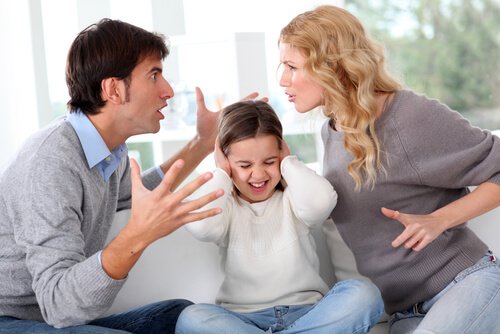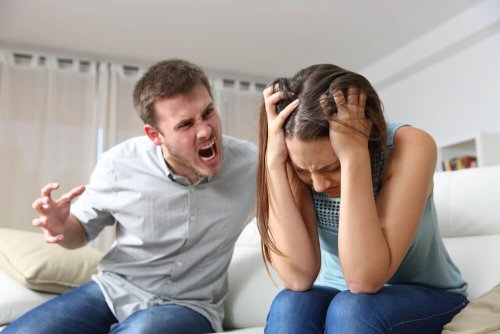Violence in Young Couples: Why is it on the Rise?

People don’t talk a lot about violence in young couples. Despite the thousands of studies on violence/physical abuse in married couples, violence hasn’t been studied a lot in young couples. This topic is quite striking since we could possibly avoid many dramatic situations if we tried to prevent this violence.
We all know someone who assaults or has assaulted their partner. And we’re not only talking about physical assault. Many people tend to think of physical altercations when they hear the word ‘assault’. However, verbal, emotional, and even sexual assault are more common than we imagine.
In spite of the fact that people are encouraging others to raise their voice and ask for help if they’re in an abusive relationship, the number of cases of violence in young couples is on the rise. Why is this happening?
Is violence in young couples a consequence of an inappropriate environment?
The University of La Laguna carried out a study where they found that there’s a close relationship between people who abuse others and what they observed growing up. It’s quite curious that when they’re angry, adult men and women tend to react significantly different. However, this doesn’t happen often in younger people.

1146 students between the ages of 16 and 18 participated in the study. Both genders showed their anger toward their partners in similar ways. However, adult men tend to be more aggressive and women more passive.
Most of the case studies affirmed that whenever these teenagers’ parents’ fought, their fathers would throw things on the floor or hit their mothers, while their mothers just cried. Also, 12% of young people confessed to having seen their father physically assaulting their mother.
When it comes to violence in young couples, it’s worth noting that teenagers who witnessed this during their childhood tend to be even more violent than their parents. Another alarming aspect they discovered was that 7% of both genders responded with physical aggression.
Why is violence on the rise in young couples?
As the study concluded, a violent family context doesn’t necessarily lead to violent behavior. There are many children who learn to avoid engaging in that type of behavior due to the uncomfortable and hurtful situations they experienced as children.
This study also concluded that there were two types of aggressive young men:
- Those with high self-esteem, who use violence as a weapon in order to control their partner.
- Those with low self-esteem, who try to ease their frustration by hurting their partner.
People must be taught to respect limits. Also, educational institutions must explain to teenagers that they shouldn’t tolerate any kind of aggression or abuse from their partner.
Some factors to take into account when it comes to studying the rise of violence in young couples are exaggerated romanticism and idealization. The new generations have grown up with unrealistic expectations regarding love and relationships. They believe that control, jealousy, and exacerbated dependence are synonymous with love.
Many theories seek to explain the unhealthy ways in which some people show their “love”. The most interesting ones are the attachment theory and the feminist perspective.

The attachment theory and its relationship with intimate partner violence
Psychiatrist and psychoanalyst John Bowlby created the attachment theory. Basically, it focuses on how important it is for a child and their caregivers to form a bond.
Attachment is something that comes naturally and influences both the child’s behavior and the way they establish relationships. In fact, it can even scar an individual’s adulthood.
That being said, the way in which these bonds are established influences the way we relate to others. This is why it’s so important to know the different attachment styles that exist and the way they’re related to violence in young couples.
Secure attachment style
This is when children have a healthy relationship with their primary caregiver (their mother, usually). When she’s not around, they’re able to interact with other people. However, in her presence, she’s always their priority since they admire her. They feel protected and comfortable because they know that she won’t let anything bad to happen to them.
During adulthood, people with secure attachment don’t have any problems establishing relationships with others. They know how to identify toxic people easily and they refuse to establish relationships just because they’re scared of being alone. In addition, they aren’t afraid to ask for help if they consider it necessary. They’re people you can have an honest, mature, and responsible relationship with.
On the other hand, individuals who never had caring, loving figures who made them feel secure and protected may become violent with their partners.
Anxious-avoidant attachment style
This is when babies don’t really care if their mother or primary caregiver is around. They’re fine without them. This is caused by a lack of repeated attention to their emotional needs.
In this case, the parent or primary caregiver avoids making contact with their child. They reject any kind of affection. Children who grow up with this attachment style more often than not have problems establishing intimate and trusting relationships. For example, they hide their emotions and needs due to their fear of rejection.
In some cases, these people may develop self-destructive behavior. They may inhibit their feelings, avoid commitment, and tend to lie and hide behind their supposed independence, which is only a barrier they use to avoid establishing intimate connections with others.
On the other hand, they feel uncomfortable if their partner asks for help. In addition, they don’t really have any problems expressing sexual desire, as long as it’s only that. Their relationships are superficial and their partner tends to feel unattended and unloved.
However, people who grew up with this attachment style don’t usually become violent.

Anxious-ambivalent attachment style
This is when babies are unable to foresee their mother’s or primary caregiver’s behavior. On occasions, they’re affectionate and loving towards them and, in others, they’re completely hostile. This ambivalence generates anguish and bewilderment in children. Thus, they tend to become tremendously hypersensitive.
They try to be close to their mother as much as they can and long for them. This is something that can end up affecting their relationships and friendships. People who grow up with this attachment style tend to feel neglected or abandoned during any separation. Their hypersensitivity leads to anger and angst, which can make their relationships extremely toxic.
This attachment style may lead to violence in young couples. The teenagers and adults who grow up with this attachment style are the most prone to abuse. Their behavior and mood swings are extremely abrupt. One minute, they give their partner all the attention they want, but become violent and hostile the next.
They tend to act this way due to everything they experienced during their childhood and due to their extreme need to avoid another traumatic abandonment.
The feminist perspective
According to feminism, violence in young couples is caused by social inequality in gender roles. Many studies establish that the percentage of men who mistreat women is much higher than that of women who abuse men. It’s an interesting statement since the study we talked about previously shows that these percentages are equal in younger couples.
According to this perspective, while the young women who assault their partners do so due to violent behavior patterns, most young men who assault their girlfriends do so because it’s part of being “macho”. They consider women objects of their possession and humiliate and assault them to reaffirm their power over them. They believe that women are inferior and must be tamed.
On the other hand, there are cases in which the man is the abuse victim. More often than not, abused men don’t report what happened to them because they believe it’s too humiliating and society will look down on them. Why do they believe this? It’s because society has always instilled in people that men must hide their emotions because they’ll seem weak if they don’t.
Early education: The key to preventing violence in young couples
These theories show us that parents have a tremendous responsibility regarding their children’s upbringing. Their actions directly affect their children, who will later become adults. However, we must bear in mind that not only marital violence is the trigger for violence in young couples, as there are many who never witnessed that at home. Variables such as context, personality, relationships, and education may also lead to this behavior.
It’s important to teach equality and respect towards others. In addition, it’s important to raise awareness that we all have the same rights despite our physical, psychological, and social differences.
Parents should be loving and affectionate towards their children and make them feel safe and protected. Someone who experienced a lot of love, protection, and happiness during their childhood is much more likely to establish respectful and joyful relationships in the future.
On the other hand, it’ll be hard for children who grew up in anxious-avoidant or anxious-ambivalent attachment styles to establish and maintain healthy relationships as adults. Thus, they may become adults who act indifferently towards their loved ones, fear abandonment, and have obsessive behaviors. All of these behaviors are toxic and should be treated if they want to enjoy healthy and prosperous relationships.
This text is provided for informational purposes only and does not replace consultation with a professional. If in doubt, consult your specialist.








